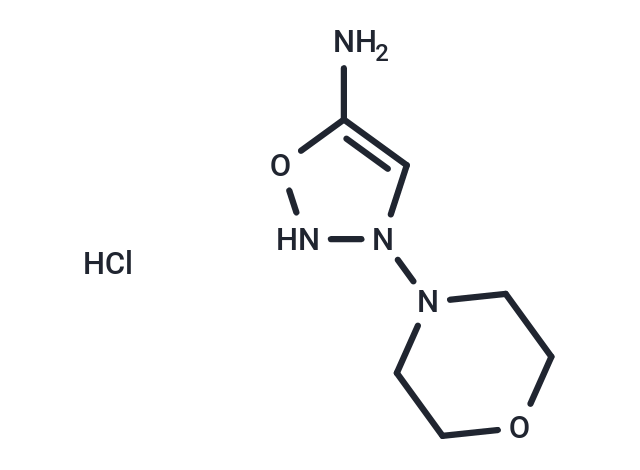Shopping Cart
Remove All Your shopping cart is currently empty
Your shopping cart is currently empty
Linsidomine hydrochloride (SIN-1 chloride) is considered as a metabolite of moxidomine, with vasodilation, inhibition of platelet aggregation, and antiangina activity. In myocardial ischemia-reperfusion models, Linsidomine hydrochloride to reduce myocardial necrosis and reperfusion induced endothelial dysfunction is associated with the cavernosal mechanism of action involved in nitric oxide release.

| Pack Size | Price | USA Warehouse | Global Warehouse | Quantity |
|---|---|---|---|---|
| 2 mg | $31 | In Stock | In Stock | |
| 5 mg | $48 | In Stock | In Stock | |
| 10 mg | $81 | In Stock | In Stock | |
| 25 mg | $156 | In Stock | In Stock | |
| 50 mg | Preferential | In Stock | In Stock | |
| 1 mL x 10 mM (in DMSO) | $54 | In Stock | In Stock |
| Description | Linsidomine hydrochloride (SIN-1 chloride) is considered as a metabolite of moxidomine, with vasodilation, inhibition of platelet aggregation, and antiangina activity. In myocardial ischemia-reperfusion models, Linsidomine hydrochloride to reduce myocardial necrosis and reperfusion induced endothelial dysfunction is associated with the cavernosal mechanism of action involved in nitric oxide release. |
| In vitro | SIN-1 decreases myocardial necrosis and reperfusion-induced endothelial dysfunction in models of myocardial ischemia-reperfusion [1][2]. |
| In vivo | SIN-1 (chloride) is the active metabolite of molsidomine. SIN-1 (chloride) exhibits a potent vasorelaxant effect and inhibition of platelet aggregation.[1] SIN-1 (chloride) decreases myocardial necrosis and reperfusion-induced endothelial dysfunction in models of myocardial ischemia-reperfusion.[2] |
| Synonyms | SIN-1 chloride |
| Molecular Weight | 206.63 |
| Formula | C6H11ClN4O2 |
| Cas No. | 16142-27-1 |
| Smiles | Cl.NC1=CN(NO1)N1CCOCC1 |
| Relative Density. | 1.303 g/cm3 at 20℃ |
| Storage | store at low temperature | Powder: -20°C for 3 years | In solvent: -80°C for 1 year | Shipping with blue ice/Shipping at ambient temperature. | |||||||||||||||||||||||||||||||||||
| Solubility Information | DMSO: 22.5 mg/mL (108.89 mM), Sonication and heating to 60℃ are recommended. H2O: 45 mg/mL (217.78 mM), Sonication is recommended. | |||||||||||||||||||||||||||||||||||
| In Vivo Formulation | 10% DMSO+40% PEG300+5% Tween-80+45% Saline: 2 mg/mL (9.68 mM), Sonication is recommeded. Please add the solvents sequentially, clarifying the solution as much as possible before adding the next one. Dissolve by heating and/or sonication if necessary. Working solution is recommended to be prepared and used immediately. The formulation provided above is for reference purposes only. In vivo formulations may vary and should be modified based on specific experimental conditions. | |||||||||||||||||||||||||||||||||||
Solution Preparation Table | ||||||||||||||||||||||||||||||||||||
DMSO/H2O
| ||||||||||||||||||||||||||||||||||||
| Size | Quantity | Unit Price | Amount | Operation |
|---|

Copyright © 2015-2026 TargetMol Chemicals Inc. All Rights Reserved.